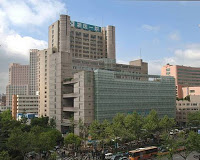The following is excerpted from the article “A Chinese Stroke Connection,” Stroke Connection Magazine, March/April 2006
“After my stroke, I was a basket case without the basket,” said Ruth Lycke, mother of three teenagers. It took a trip to China and treatment with that country’s non-traditional medicine to get her close to being her old self.
In November 2001, Ruth had an inoperable brain stem hemorrhage. “They thought I would die in the first 24 hours,” she said “I actually had two strokes, the brain stem bleed and a secondary stroke. I was in a coma for five days.”
When she awoke, she had double vision, no mobility or feeling on the right side of her body, limited left side mobility and no balance. She also had cognitive deficits. “Words were my enemy,” she said.
The double vision was profoundly distressing because it affected everything else in her recovery. “Not only did I see two of everything, but everything I looked at bounced. There was constant motion. And any fatigue would prevent me from thinking linearly. I repeated myself a lot, which challenged my husband Steve and our three kids, who were between the ages of 9 and 13 at that time.”
By two years post-stroke, she had made a remarkable recovery, but her life and her body were not where she wanted them. “I still had double vision and difficulty walking. I was incontinent. I didn’t get out very much, and when I did, it was difficult. I became more or less a shut-in.”
There was no stroke support group in her hometown of Marshalltown, Iowa, so she started one with the help of the American Stroke Association.
“My doctors told me to be content with what had returned,” she said. “But nothing worked right, so I wasn’t content.”
The Lyckes had hosted foreign exchange students for several years, and during this period they hosted two girls from China. Ruth learned about Chinese medicine from them, and they used their Chinese language skills to search the Internet for information on stroke and traditional medicine. That’s how she found the First Teaching Hospital and University of Traditional Chinese Medicine in Tianjin, China.
After forwarding her medical records to the hospital, she talked to a doctor. “He asked me, ‘What do you want me to do for you?’ I had never had a doctor ask me that question before. So I gave him my list: normal vision, restored balance, feeling on my right side, improved walking and fine motor movement on my right side. Then he said, ‘We can fix you.’ I couldn’t believe it, so I asked him to repeat it.”
Ruth flew to China alone, a long trek for someone with her deficits. Once there, she was escorted by the families of her exchange students until she reached the hospital. “I arrived at 10 in the morning, and by 2 o’clock I was already in therapy,” she said. “Their therapy is very intense. I had acupuncture twice a day, involving anywhere from 40 to 100 needles – from the tip of my head to my toes on both sides. By the way, the needles don’t hurt. They’re very thin.
“I also had herbal soaks on my right foot and arm. Then there was 40 to 60 minutes of intense massage, which is done by a doctor. I was busy from early morning to late at night every day.”
Ruth had tried acupuncture in the United States with limited results, but “after my first treatment in China, my little finger felt normal for the first time since the stroke. Within 10 days I regained some degree of feeling in my entire right side. Things would go from no feeling, to intense pain, to weighty feeling, to normal.
“When feeling began to return, I was like a kid in a candy shop,” said Ruth. “I would reach out and touch the wall, feel the bumps or the crack where the paint came together. It was remarkable to me.”
Although the hospital treats many Europeans, she was its first American patient, so Ruth received lots of attention. “Probably once a week I went to dinner with a doctor. In fact, it wasn’t unusual to have dinner with two or three doctors.”
The food was an important part of the experience, and one of the most impressive. “All the food was farm fresh. I had an egg or rice soup for breakfast, and then ordered traditional Chinese food for the evening meal from an English menu. The food was very good.”
Ruth’s treatment cost about $4,000 a month, including meals and a comfortable room. After two months, she had made enough progress that she extended her stay for five months, “to get everything fixed, especially my vision.” She considers the $20,000 a bargain for the results produced.
Her experience was good enough that she returned to Tianjin last summer, accompanying two American stroke survivors for treatment. She has four trips planned for 2006.
“I no longer suffer from bouncing double vision, even when I’m tired,” Ruth said. “I can jump around on the basketball court with my 14-year-old daughter Elizabeth, who is also very excited that I can walk now, so I can take her to the mall. My balance is back, and the fine motor stuff is returning. I can use the remote control now, and scissors. I can walk without difficulty. I have feeling in my face. Words are my friend again. I wrote a book about my experience, and it’s been published. Everything on my list was done. They pretty much gave me my life back.”
The information contained in Stroke Connection is provided by the American Stroke Association as a resource. The services or products listed are not owned or provided by the American Stroke Association. Additionally, the products or services have not been evaluated and their listing or advertising should not be construed as a recommendation or endorsement of these products or services.









